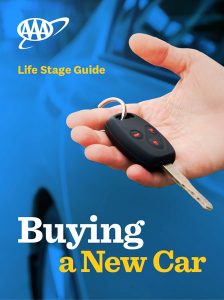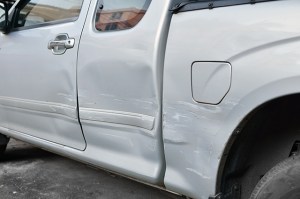What connotations come to mind with the words “car keys?” Bad thoughts, like frantically ransacking your house, bags and pockets in search of them? Good thoughts, like being handed them for the first time at a dealership or flicking your wrist and hearing the engine come alive?
Either way, these experiences are likely to soon be stowed-away memories of a different time: The truth is, the history of car keys as we know them is quickly coming to a close.
Just about every other aspect of automotive technology has drastically evolved over the past century, and the keys we use to open and start our cars are no different. But car key history is unique in that instead of simply improving the feature, current technology has rendered traditional car keys obsolete, sending them the way of the dodo, car ashtrays and crank windows.
That renders the age-old question: How did we get here? Let’s take a look back.

The History of Car Keys Begins
Car key history can be traced back to 1910, but these early versions didn’t start the engine or ignition. Instead, the first car keys controlled the ignition’s electrical circuit. Using the key, car owners could switch off the flow of electrical current, making it impossible to start the vehicle. Once the switch was on, the ignition could be activated, although drivers still had to then crank up the engine.
Soon after, keys that could lock and unlock both the electrical circuit and the ignition became more common.
Because it was still impossible to start the engine without a key, car theft was not a concern, and “locking” a car wasn’t a practice. In fact, most early automobiles were roofless and some were even door-less.
Mid-Century Car Keys
A major milestone in car key history occurred in 1949 when Chrysler unveiled the first car key that could start a vehicle’s engine all on its own. It was able to do so through the use of an ignition tumbler, or ignition lock cylinder.
In 1965, Ford became the first manufacturer to introduce double-sided keys that could be inserted into the tumbler either way. While seemingly elementary by today’s standards, these types of car keys remained the norm for decades.
This was also around the same the time the dual key, which could both start the car and unlock the doors, took hold. Prior to the 1960s, some vehicles still required two separate car keys.

Car Keys Meet Technology
Car key evolution was mostly dormant for the next quarter century but took some momentous leaps in the 1990s. It was this decade that saw the rise of the now ubiquitous key fob.
Remote keyless entry fobs allowed car owners to lock and unlock vehicle doors from afar by emitting a coded signal through radio waves to a receiver in the car. As technology developed, key fobs gained more functions, such as opening the trunk or sliding doors and starting the engine remotely.
(If you’re curious about the strange name, according to The Atlantic, “fob” may come from the word “fuppe,” which means “pocket” in the low German dialect.)
Car fobs are very expensive to replace. Make sure you’re protected with AAA’s Tire & Wheel Program, which covers lost keys and key fobs up to $5,000.

Car Keys Today
The traditional, mechanical car key is quickly becoming a thing of the past – if it’s not already a relic of automotive history. Almost all of today’s new vehicles have some version of a keyless entry and push-button start system. In fact, according to consumer auto research firm Edmunds, 91% of 2019 model-year vehicles had keyless ignitions. That’s up from 72% in 2014.
We’ve come a long way from having to carry one key for the engine and one key for the doors. But apparently one key is still one too many: Drivers can now store a digital car key on – where else – their phones.

Apple’s Wallet app includes a feature to add your car key. In order to do this, you need to have a compatible car as well as an iPhone or Apple Watch. Once installed, a user simply places their phone or watch next to the car’s door handle to unlock the vehicle. To start the car, they just place the phone or watch in the car’s key reader and press the start button. When an owner wants to share their key, they can simply send an iMessage to that user, which tells them how to add and use the car key.
Tesla owners can use the company’s smartphone app to do many of the same things. The app can track a driver’s smartphone from up to 30 feet away and automatically unlock the doors by the time they reach the car. But the electric automaker isn’t alone. About 31 brand marques, including BMW, Chevrolet, Chrysler, Dodge, Hyundai and Lincoln offer digital car keys, making the trend’s rise seem more assured and imminent.
What are your thoughts on car keys today? Do you like the idea of a digital key on your phone or would rather have a tangible key you can hold? Let us know in the comments below?
For more automotive history, visit AAA.com.
109 Thoughts on “The History of Car Keys”
Leave A Comment
Comments are subject to moderation and may or may not be published at the editor’s discretion. Only comments that are relevant to the article and add value to the Your AAA community will be considered. Comments may be edited for clarity and length.












I would like the key to always be available.
A car key is primitive and free of the complexities of breakdowns and works 100% of the time. A car key also requires and promotes careful habits of the owner and, therefore, contributes to an orderly and careful life style. Car keys 10; electronics 5.
Absolutely prefer a KEY. Fob is way too expensive an item to replace. I like the manual opening of the car door as a back up too. My 2007 Subaru is the last year before electronics were introduced and at 214,000 miles it has served me well. Door lock and unlock is on a separate piece from the key, and there is a key insert in the door handle. The small battery lasts for years. The last thing I want is my car interfaced with my phone.
I used to be able to get a copy of my key for $2.00. Now it’s $100.00. That’s the ONLY reason for the change. And there’s no need for it to cost that much, it’s just a flash drive, and a tiny one. A key fob has ZERO advantage over a key.
Computers are great. They are not ALWAYS the best way to do things, and this is an example.
TODAYS CARS ARE JUST TELEPHONES ON WHEELS. THEY FORCE THEIR “CONTROL” ON US WE DO NO HAVE ANY CHOICE. OF COURSE CAR KEYS ARE BETTER AND SAFER!
I should think that if a phone can become a car key by simply sending it a code, then anyone with such a phone can steal your car. I don’t like the idea.
I also like car keys. There is a reason the expression “keep it simple stupid” never goes out of style. The more complex the more problems. I hope we haven’t gotten so lazy we cannot start our own cars
Key fobs of today are the answer to a question nobody asked. Give me a real key any day. That way I can never lock myself our of my car.
I prefer to have both options.
After driving my new car for about 6 months I came out of a store to return home. I couldn’t open the doors or start the car because the battery in the FOB was dead. I could use the “hidden” key in the FOB to open the doors but still could go nowhere. I had to call home and have my spouse bring my the spare FOB.
I prefer keys.
My key fob is always bumping something else in my pocket and doing random functions. I can be working in the garden and accidentally remotely start the car in the garage, filling it with carbon monoxide. I feel safer if I approach my car and find it locked. If it automatically unlocks from 30 feet away, and I find it unlocked, I wonder if I have been forgetting to lock it. It’s nice to find my car by remotely making it beep, as long as this also locks it. Remote locking is convenient in case you don’t remember to lock it until after you’ve walked away. But remote start and remote unlock are dangerous. A key in the fob is a lifesaver when there’s a battery problem.
I prefer the key. Far more reliable. No dependence on battery to enter the vehicle or engage it to start.
I say “keep it simple” and stick to the reliable metal key. Don’t rely on a battery operated device to lock and unlock the vehicle. Batteries do eventually fail and who wants that in an emergency. As the old saying goes, “If it’s not broken, don’t fix it”.
I really enjoyed this and shared it with friends who I thought might. Thank you.
Having an old style key in the FOB is great for back-up. You never know when the battery will fail. Some things shouldn’t go out of style…
I prefer keys. The battery dying on a fob is a real issue, and fumbling with a phone seems ridiculous. Those fobs are very expensive to replace. I have a 97 Honda Civic that runs well. It has a key, and I’m likely to keep it for the same reason others have mentioned: not to have to deal with that expensive fob.
I prefer a key, too. I am young enough to remember that using the family car meant getting permission from my mom or dad—that permission in the form of them handing me their keys to the car. What would we do today? What do the legal-eagles think? The keys were a tangible evidence of permission granted.
I would definitely prefer a key. The fob is heavy. When I pick up my car at night or in a remote area, I always have a second of worry if the battery might have died. I’d be stuck. Also, being a senior, I remember the days when you tapped a button on the floor with your left foot to control the high/dimmer lights. The left foot does nothing, whereas if you have to free one hand to jiggle the control while you’re trying to turn, it’s also a moment of anxiety. Otherwise, glad for a.c., seat controls, better speakers.
I am old enough to remember when some cars offered a switch buy no lock.
Keys preferred – less bulk and an extra one or two can be used if lost – fob is heavy and with phone etc – too much weighing us down. I want to be in control – not automation of everything.